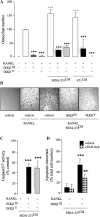Pharmacological Inhibition of the Skeletal IKKβ Reduces Breast Cancer-Induced Osteolysis
- PMID: 29455416
- PMCID: PMC6061461
- DOI: 10.1007/s00223-018-0406-4
Pharmacological Inhibition of the Skeletal IKKβ Reduces Breast Cancer-Induced Osteolysis
Abstract
IKKβ has previously been implicated in breast cancer bone metastasis and bone remodelling. However, the contribution of IKKβ expressed by bone cells of the tumour microenvironment to breast cancer-induced osteolysis has yet to be investigated. Here, we studied the effects of the verified selective IKKβ inhibitors IKKβIII or IKKβV on osteoclast formation and osteoblast differentiation in vitro and in vivo, human and mouse breast cancer cells' support for osteoclast formation and signalling in vitro and osteolysis ex vivo and in immunocompetent mice after supracalvarial injection of human MDA-MB-231 conditioned medium or intra-cardiac injection of syngeneic 4T1 breast cancer cells. Pre-treatment with IKKβIII or IKKβV prior to exposure to tumour-derived factors from human and mouse breast cancer cell lines protected against breast cancer-induced osteolysis in two independent immunocompetent mouse models of osteolysis and the ex vivo calvarial bone organ system. Detailed functional and mechanistic studies showed that direct inhibition of IKKβ kinase activity in osteoblasts and osteoclasts was associated with significant reduction of osteoclast formation, enhanced osteoclast apoptosis and reduced the ability of osteoblasts to support osteoclastogenesis in vitro. When combined with previous findings that suggest NFκB inhibition reduces breast cancer tumorigenesis and metastasis our present findings have an important clinical implication on raising the possibility that IKKβ inhibitors, as bone anabolics, osteoclast inhibitors as well as anti-metastatic agents, may have advantages over anti-osteoclasts agents in the treatment of both skeletal and non-skeletal complications associated with metastatic breast cancer.
Keywords: Bone; Breast cancer; IKKβ; Osteoclast; Osteoclastogenesis; Osteolysis.
Conflict of interest statement
Conflict of interest
Patrick Mollat is an employee of Galapagos SASU (102 Avenue Gaston Roussel, 93230 Romainville, France). Silvia Marino, Ryan T. Bishop and Aymen I. Idris declare that they have no conflict of interest.
Human and Animal Rights and Informed Consent
All procedures involving mice and their care were approved by and performed in compliance with the guidelines of Institutional Animal Care and Use Committee of University of Edinburgh (Scotland, UK).
Figures





Similar articles
-
Pharmacological evidence for the bone-autonomous contribution of the NFκB/β-catenin axis to breast cancer related osteolysis.Cancer Lett. 2017 Dec 1;410:180-190. doi: 10.1016/j.canlet.2017.09.034. Epub 2017 Sep 28. Cancer Lett. 2017. PMID: 28965856
-
Pharmacological Inhibition of NFκB Reduces Prostate Cancer Related Osteoclastogenesis In Vitro and Osteolysis Ex Vivo.Calcif Tissue Int. 2019 Aug;105(2):193-204. doi: 10.1007/s00223-019-00538-9. Epub 2019 Mar 30. Calcif Tissue Int. 2019. PMID: 30929064
-
Bone Cell-autonomous Contribution of Type 2 Cannabinoid Receptor to Breast Cancer-induced Osteolysis.J Biol Chem. 2015 Sep 4;290(36):22049-60. doi: 10.1074/jbc.M115.649608. Epub 2015 Jul 20. J Biol Chem. 2015. PMID: 26195631 Free PMC article.
-
Breast cancer metastasis to the bone: mechanisms of bone loss.Breast Cancer Res. 2010;12(6):215. doi: 10.1186/bcr2781. Epub 2010 Dec 16. Breast Cancer Res. 2010. PMID: 21176175 Free PMC article. Review.
-
The role of the alphaVbeta3 integrin in the development of osteolytic bone metastases: a pharmacological target for alternative therapy?Calcif Tissue Int. 2002 Oct;71(4):293-9. doi: 10.1007/s00223-001-2071-1. Epub 2002 Aug 6. Calcif Tissue Int. 2002. PMID: 12154391 Review.
Cited by
-
Gold clusters prevent breast cancer bone metastasis by suppressing tumor-induced osteoclastogenesis.Theranostics. 2020 Mar 4;10(9):4042-4055. doi: 10.7150/thno.42218. eCollection 2020. Theranostics. 2020. PMID: 32226538 Free PMC article.
-
Analysis of Signaling Pathways by Western Blotting and Immunoprecipitation.Methods Mol Biol. 2025;2885:195-208. doi: 10.1007/978-1-0716-4306-8_10. Methods Mol Biol. 2025. PMID: 40448762
-
Ex vivo Bone Models and Their Potential in Preclinical Evaluation.Curr Osteoporos Rep. 2021 Feb;19(1):75-87. doi: 10.1007/s11914-020-00649-5. Epub 2021 Jan 11. Curr Osteoporos Rep. 2021. PMID: 33428030 Free PMC article. Review.
-
The Secretome of Parental and Bone Metastatic Breast Cancer Elicits Distinct Effects in Human Osteoclast Activity after Activation of β2 Adrenergic Signaling.Biomolecules. 2023 Mar 30;13(4):622. doi: 10.3390/biom13040622. Biomolecules. 2023. PMID: 37189370 Free PMC article.
References
-
- Gasparian AV, Yao YJ, Kowalczyk D, Lyakh LA, Karseladze A, Slaga TJ, Budunova IV. The role of IKK in constitutive activation of NF-kappaB transcription factor in prostate carcinoma cells. J Cell Sci. 2002;115:141–151. - PubMed
-
- Jourdan M, Moreaux J, Vos JD, Hose D, Mahtouk K, Abouladze M, Robert N, Baudard M, Reme T, Romanelli A, Goldschmidt H, Rossi JF, Dreano M, Klein B. Targeting NF-kappaB pathway with an IKK2 inhibitor induces inhibition of multiple myeloma cell growth. Br J Haematol. 2007;138:160–168. doi: 10.1111/j.1365-2141.2007.06629.x. - DOI - PMC - PubMed
Publication types
MeSH terms
Substances
Grants and funding
LinkOut - more resources
Full Text Sources
Other Literature Sources
Medical
Miscellaneous

